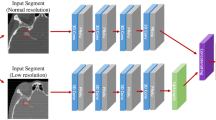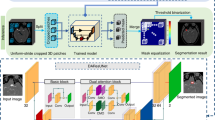Abstract
Purpose
Cerebrovascular aneurysms are being observed with rapidly increasing incidence. Therefore, tools are needed for accurate and efficient detection of aneurysms. We used deep learning techniques with CT angiography acquired from multiple medical centers and different machines to develop and evaluate an automatic detection model.
Methods
In this study, we have introduced a deep learning model, the faster RCNN model, in order to develop a tool for automatic detection of aneurysms from medical images. The inputs of the model were 2D nearby projection (NP) images from 3D CTA, which were made by the NP method proposed in this study. This method made aneurysms clearly visible on images and improved the model’s performance. The study included 311 patients with 352 aneurysms, selected from three hospitals, and 208 and 103 of these patients, respectively, were randomly selected to train and test the models.
Results
The sensitivity of the trained model was 91.8%. For aneurysm sizes larger than 3 mm, the sensitivity of successful aneurysm detection was 96.7%. We achieved state-of-the-art sensitivity for > 3 mm aneurysms. The sensitivities also indicated that there was no significant difference among aneurysms at different locations in the body. Computing time for the detection process was less than 25 s per case.
Conclusions
We successfully developed a deep learning model that can automatically detect aneurysms. The model performed well for aneurysms of different sizes or in different locations. This finding indicates that the deep learning model has the potential to vastly improve clinician performance by providing automated aneurysm detection.






Similar content being viewed by others
Explore related subjects
Discover the latest articles, news and stories from top researchers in related subjects.References
Vlak MH, Algra A, Brandenburg R, Rinkel GJ (2011) Prevalence of unruptured intracranial aneurysms, with emphasis on sex, age, comorbidity, country, and time period: a systematic review and meta-analysis. Lancet Neurol 10(7):626–636
Ajiboye N, Chalouhi N, Starke RM, Zanaty M, Bell R (2015) Unruptured cerebral aneurysms: evaluation and management. Sci World J 2015:1–11
Van Gijn J, Kerr RS, Rinkel GJ (2007) Subarachnoid haemorrhage. Lancet 369(9558):306–318
Etminan N, Chang H-S, Hackenberg K, de Rooij NK, Vergouwen MD, Rinkel GJ, Algra A (2019) Worldwide incidence of aneurysmal subarachnoid hemorrhage according to region, time period, blood pressure, and smoking prevalence in the population: a systematic review and meta-analysis. JAMA Neurol 76(5):588–597
Kato Y, Sano H, Katada K, Ogura Y, Hayakawa M, Kanaoka N, Kanno T (1999) Application of three-dimensional CT angiography (3D-CTA) to cerebral aneurysms. Surg Neurol 52(2):113–122
Uysal E, Yanbuloglu B, Ertürk M, Kilinç BM, Basak M (2005) Spiral CT angiography in diagnosis of cerebral aneurysms of cases with acute subarachnoid hemorrhage. Diagn Interv Radiol 11(2):77
Westerlaan HE, Van Dijk J, Jansen-van der Weide MC, de Groot JC, Groen RJ, Mooij JJA, Oudkerk M (2011) Intracranial aneurysms in patients with subarachnoid hemorrhage: CT angiography as a primary examination tool for diagnosis—systematic review and meta-analysis. Radiology 258(1):134–145
Miki S, Hayashi N, Masutani Y, Nomura Y, Yoshikawa T, Hanaoka S, Nemoto M, Ohtomo K (2016) Computer-assisted detection of cerebral aneurysms in MR angiography in a routine image-reading environment: effects on diagnosis by radiologists. Am J Neuroradiol 37(6):1038–1043
Lauric A, Miller E, Frisken S, Malek AM (2010) Automated detection of intracranial aneurysms based on parent vessel 3D analysis. Med Image Anal 14(2):149–159
Arimura H, Li Q, Korogi Y, Hirai T, Abe H, Yamashita Y, Katsuragawa S, Ikeda R, Doi K (2004) Automated computerized scheme for detection of unruptured intracranial aneurysms in three-dimensional magnetic resonance angiography. Acad Radiol 11(10):1093–1104
Yang X, Blezek DJ, Cheng LT, Ryan WJ, Kallmes DF, Erickson BJ (2011) Computer-aided detection of intracranial aneurysms in MR angiography. J Digit Imaging 24(1):86–95
Ardila D, Kiraly AP, Bharadwaj S, Choi B, Reicher JJ, Peng L, Tse D, Etemadi M, Ye W, Corrado G (2019) End-to-end lung cancer screening with three-dimensional deep learning on low-dose chest computed tomography. Nat Med 25(6):954
Sun W, Zheng B, Qian W (2017) Automatic feature learning using multichannel ROI based on deep structured algorithms for computerized lung cancer diagnosis. Comput Biol Med 89:530–539
Coudray N, Ocampo PS, Sakellaropoulos T, Narula N, Snuderl M, Fenyö D, Moreira AL, Razavian N, Tsirigos A (2018) Classification and mutation prediction from non–small cell lung cancer histopathology images using deep learning. Nat Med 24(10):1559
Abràmoff MD, Lou Y, Erginay A, Clarida W, Amelon R, Folk JC, Niemeijer M (2016) Improved automated detection of diabetic retinopathy on a publicly available dataset through integration of deep learning. Invest Ophthalmol Vis Sci 57(13):5200–5206
Pratt H, Coenen F, Broadbent DM, Harding SP, Zheng Y (2016) Convolutional neural networks for diabetic retinopathy. Procedia Comput Sci 90:200–205
Ting DSW, Cheung CY-L, Lim G, Tan GSW, Quang ND, Gan A, Hamzah H, Garcia-Franco R, San Yeo IY, Lee SY (2017) Development and validation of a deep learning system for diabetic retinopathy and related eye diseases using retinal images from multiethnic populations with diabetes. JAMA 318(22):2211–2223
Flanders AE (2018) Machine learning detection of intracranial aneurysms—will it play in Peoria?. Radiological Society of North America, Oak Brook
Stember JN, Chang P, Stember DM, Liu M, Grinband J, Filippi CG, Meyers P, Jambawalikar S (2019) Convolutional neural networks for the detection and measurement of cerebral aneurysms on magnetic resonance angiography. J Digit Imaging 32(5):808–815
Nakao T, Hanaoka S, Nomura Y, Sato I, Nemoto M, Miki S, Maeda E, Yoshikawa T, Hayashi N, Abe O (2018) Deep neural network-based computer-assisted detection of cerebral aneurysms in MR angiography. J Magn Reson Imaging 47(4):948–953
Ueda D, Yamamoto A, Nishimori M, Shimono T, Doishita S, Shimazaki A, Katayama Y, Fukumoto S, Choppin A, Shimahara Y (2018) Deep learning for MR angiography: automated detection of cerebral aneurysms. Radiology 290(1):187–194
Park A, Chute C, Rajpurkar P, Lou J, Ball RL, Shpanskaya K, Jabarkheel R, Kim LH, McKenna E, Tseng J (2019) Deep learning-assisted diagnosis of cerebral aneurysms using the HeadXNet model. JAMA Netw Open 2(6):e195600–e195600
Lv F, Li Q, Liao J, Luo T, Shen Y, Li J, Zhang J, Xie P (2011) Detection and characterization of intracranial aneurysms with dual-energy subtraction CTA: comparison with DSA. In: Feng H, Mao Y, Zhang JH (eds) Early brain injury or cerebral vasospasm. Springer, pp 239–245
He K, Zhang X, Ren S, Sun J (2016) Deep residual learning for image recognition. In: Proceedings of the IEEE conference on computer vision and pattern recognition. pp 770–778
Ren S, He K, Girshick R, Sun J (2015) Faster r-cnn: towards real-time object detection with region proposal networks. In: Advances in neural information processing systems. pp 91–99
Jianwei Y, Lu J, Batra D, Parikh D (2017) A faster Pytorch implementation of faster R-CNN. https://github.com/jwyang/faster-rcnnpytorch. Accessed 2 Nov 2019
Sichtermann T, Faron A, Sijben R, Teichert N, Freiherr J, Wiesmann M (2019) Deep learning-based detection of intracranial aneurysms in 3D TOF-MRA. Am J Neuroradiol 40(1):25–32
Shojima M, Morita A, Nakatomi H, Tominari S (2017) Size is the most important predictor of aneurysm rupture among multiple cerebral aneurysms: post hoc subgroup analysis of unruptured cerebral aneurysm study Japan. Neurosurgery 82(6):864–869
Ishibashi T, Murayama Y, Urashima M, Saguchi T, Ebara M, Arakawa H, Irie K, Takao H, Abe T (2009) Unruptured intracranial aneurysms: incidence of rupture and risk factors. Stroke 40(1):313–316
Davies RR, Goldstein LJ, Coady MA, Tittle SL, Rizzo JA, Kopf GS, Elefteriades JA (2002) Yearly rupture or dissection rates for thoracic aortic aneurysms: simple prediction based on size. Ann Thorac Surg 73(1):17–28
Wiebers DO, Investigators ISoUIA (2003) Unruptured intracranial aneurysms: natural history, clinical outcome, and risks of surgical and endovascular treatment. Lancet 362(9378):103–110
Acknowledgements
This study was supported by generous assistance from Dr Fengping Zhu, Department of Neurosurgery, Huashan Hospital, Fudan University.
Funding
No funding.
Author information
Authors and Affiliations
Corresponding author
Ethics declarations
Conflict of interest
The authors declare that they have no conflict of interest.
Ethical approval
All procedures performed in studies involving human participants were in accordance with the ethical standards of the institutional and/or national research committee and with the 1964 Helsinki Declaration and its later amendments or comparable ethical standards.
Informed consent
Informed consent was obtained from all individual participants included in the study.
Additional information
Publisher's Note
Springer Nature remains neutral with regard to jurisdictional claims in published maps and institutional affiliations.
Rights and permissions
About this article
Cite this article
Dai, X., Huang, L., Qian, Y. et al. Deep learning for automated cerebral aneurysm detection on computed tomography images. Int J CARS 15, 715–723 (2020). https://doi.org/10.1007/s11548-020-02121-2
Received:
Accepted:
Published:
Issue Date:
DOI: https://doi.org/10.1007/s11548-020-02121-2




